Set data structure 2
- 4. Simplest and straight forward Best suited for dynamic storage facility. This allow multiplicity of elements ie; Bag structure. All operations can be easily implemented and performance of these operations are as good as compared to other representations. Ex: set S = { 5,6,9,3,2,7,1} using linked list structure is 5 6 9 3 1 7 2
- 5. UNION: Si: Si: 5 Si: 6 9 3 2 Sj: 7 6 1 5 Si U Sj: 5 6 9 3 1 7 2
- 6. ALGORITHM : UNION_LIST_SETS(Si,Sj;S) Input: Si and Sj are header of two single linked list representing two distinct sets. Output: S is the union of Si and Sj. Data structure: Linked list representation of set.
- 7. STEPS /* to get a header note for S and initialize it*/ 1. S= GETNODE(NODE) 2. S.LINK= NULL, S.DATA = NULL /* to copy the entire list of Si into S*/ 3. ptri = si.LINK 4. While (ptri !=NULL) do 1.Data = ptri.data 2.INSERT_SL_FRONT(S, DATA) 3. ptri= ptri.LINK 5.Endwhile /* for each element in Sj added to S if it 6.ptrj=Sj.LINK is not in Si*/
- 8. 7. While (ptrj!=NULL) do ptri=Si.link while (ptri. DATA != ptrj. DATA) do 1. ptri=ptri.LINK 8. Endwhile 9.If (ptri=NULL) then INSERT_SL_FRONT(S,ptrj.DATA) 10. EndIf 11. ptrj=ptrj.LINK 12. Endwhile 13. Return (S) 14. stop
- 9. INTERSECTION Si: Si: 5 Si: 6 9 3 2 Sj: 7 6 1 5 Si Sj 5 6
- 10. ALGORITHM : INTERSECTION_LIST_SETS(Si,Sj;S) Input: Si and Sj are header of two single linked list representing two distinct sets. Output: S is the intersection of Si and Sj. Data structure: Linked list representation of set.
- 11. STEPS: /*To get a header node for S and initialize it*/ 1. S= GETNODE(NODE) 2. S. LINK= NULL, S. DATE= NULL /*search the list Sj, for each element in Si*/ 3. ptri= Si.LINK 4. While (ptri!= NULL) do 1. ptrj= Sj.LINK 2. While(ptrj.DATA!= ptri.DATA) and(ptrj !=NULL) do 1. ptrj= ptrj. LINK
- 12. 3. Endwhile. 4. If (ptrj!=NULL) then // when the element is found in Sj 1. INSERT_SL_FRONT(S,ptrj,DATA) 5. EndIf 6. ptri = Si.LINK 5. Endwhile 6. Return(S) 7.Stop.
- 13. DIFFERENCE: Si: Si: 5 Si: 6 9 3 2 Sj: 7 6 1 5 Si –Sj: 5 6 2
- 14. ALGORITHM : DIFFERENCE_LIST_SETS(Si,Sj;S) Input: Si and Sj are header of two single linked list representing two distinct sets. Output: S is the difference of Si and Sj. Data structure: Linked list representation of set.
- 15. STEPS: /*Get a header node forS and initialize it*/ 1.S= GETNODE(NODE ) 2. S.LINK= NULL,S. DATA =NULL /*Get S’ the intersection of Si, and Sj*/ 3. S‟= INTERSECTION _LIST_SET_(Si, Sj) /* Copy the entire list Si into S*/ 4.ptri= Si. LINK 5. While (ptri.LINK!=NULL) do 1. INSERT_SL_FRONT(S.ptri.DATA) 2. ptri=ptri.LINK 6. Endwhile
- 16. /* For each element in S’. Delete it from S if it is there*/ 7.ptr= S‟.LINK 8.While (ptr!=NULL) do 1. DELETE_SL_ANY(S,ptr.DATA) 2. ptr=ptr.LINK 9. Endwhile 10.Return (S) 11.Stop.
- 17. ALGORITHM : EQUALITY_LIST_SETS(Si,Sj) Input: Si and Sj are header of two single linked list representing two distinct sets. Output: Return TRUE if two sets Si and Sj equal else FALSE Data structure: Linked list representation of set.
- 18. STEPS 1. li= 0, lj =0 2.ptr=Si.LINK // to count Si 3.while (ptr!=NULL) do 1. li=li+1 2. ptr=ptr.LINK 4.Endwhile 5. ptr=Sj.LINK //to count Sj 6. While (ptr!=NULL) do 1. lj=lj+1 2. ptr=ptr.LNIK 7.Endwhile 8. If (li !=lj) then 1. flag = FALSE 2. exit . 9.Endif /*compare the elements in Si and Sj*/
- 19. 10. ptri= Si.LINK,flag=TRUE 11. While (ptril!=NULL )and (flag = TURE) do 1. ptrj=sj.LINK 2. while (ptrj.DATA !=ptri.DATA)and (ptrj!=NULL) do 1.ptrj=ptrj.LINK 3. Endwhile 4.ptri=ptri.LINK 5. If (ptrj= NULL)then 1. flag= FALSE 6.Endif 12. Endwhile 13.Return(flag) 14.Stop.
- 21. ►Here a tree is used to represent one set, and the each element in the set has the same root. ►Each element in a set has pointer to its parent. ►Let us consider sets S1 ={1,3,5,7,9,11,13} S2 ={2,4,8} S1 S3 ={6} S2 S3 1 6 2 3 5 7 9 S3 ={6} 4 8 11 13 S1 ={1,3,5,7,9,11,13} S2 ={2,4,8}
- 22. Tree representation of set S1 ={1,3,5,7,9,11,13} S1 1 3 5 7 9 11 13 0 -- 1 -- 1 -- 1 -- 1 -- 7 -- 7 -- -- -- 1 2 3 4 5 6 7 8 9 10 11 12 13 14 15 16
- 23. Illustration of FIND method S1 S2 S3 1 3 2 5 7 6 9 4 8 11 -4 -3 -3 2 1 3 1 1 3 -- 7 -- -- -- -- -- 1 2 3 4 5 6 7 8 9 10 11 12 13 14 15 16
- 25. Here the elements in collection are separated in to number of buckets. Each bucket can hold arbitrary number of elements. Consider set S ={2,5,7,16,17,23,34,42} Here hash table with 4 buckets and H(x) hash function can store which can place element from S to any of the four buckets. Bucket 1 16 Bucket 2 5 17 Bucket 3 2 34 42 Bucket 4 7 23
- 26. A B C B N -- Q D E E S F -- G V S T -- -- H I J I K L X K Z Set Si Set Sj
- 27. UNION: S = Si U Sj A B C N Q D E S F G V U T -- H I J K L X Z
- 28. INTERSECTION DIFFERENCE B A C -- -- E D -- F -- G -- -- I H J K L Si Sj Si -Sj
- 30. VARIATION OF SETS MAINTAINING THE MAINTAINING ACTUAL INDICATION OF DATA VALUE PRESENCE OR ABSENCE OF DATA
- 31. A set, giving the records about the age of cricketer less than or equal to 35 is as given below: {0,0,0,0,1,1,1,1,0,1,1} Here 1 indicates the presence of records having the age less than or equal to 35. 0 indicates the absence of records having the age less than or equal to 35. As we have to indicate presence or absence of an element only, so 0 or 1 can be used for indication for saving storage space A bit array data structure is known for this purpose. A bit array is simply an array containing values 0 or 1(binary).
- 32. • It is very easy to implement set operation on the bit array data structure. • The operations are well defined only if the size of the bit arrays representing two sets under operation are of same size.
- 33. To obtain the union of sets si and sj, the bit-wise OR operation can be used Si and Sj are given below: Si = 1001011001 Sj = 0011100100 Si U Sj = 1 0 1 1 1 1 1 1 0 1
- 34. ALGORITHM : UNION_BIT_SETS(Si,Sj;S) Input: Si and Sj are two bit array corresponding to two sets. Output: A bit array S is the result of Si U Sj. Data structure: Bit vector representation of set.
- 35. 1. li=LENGTH(Si) //Size of Si. 2. li=LENGTH(Sj) //Size of Sj. 3. If (li != lj) then 1.Print “Two sets are not compatible for union” 2.Exit 4. End if /*Loop over the under lying bit arrays and bit- wise OR on its constituents data.*/ 5. For i=1 to li do 1.S[i] = Si[i] OR Sj[i] 6. EndFor 7. Return(S) 8. Stop
- 36. To obtain the intersection of sets si and sj, the bit- wise AND operation can be used Si and Sj are given below: Si = 1001011001 Sj = 0011100100 Si Sj = 0 0 0 1 0 0 0 0 0 0
- 37. ALGORITHM : INTERSECTION_BIT_SETS(Si,Sj;S) Input: Si and Sj are two bit array corresponding to two sets. Output: A bit array S is the result of Si Sj. Data structure: Bit vector representation of set.
- 38. 1. li=LENGTH(Si) //Size of Si. 2. li=LENGTH(Sj) //Size of Sj. 3. If (li != lj) then 1.Print “Two sets are not compatible for intersection” 2.Exit 4. End if /*Loop over the under lying bit arrays and bit-wise AND on its constituents data.*/ 5. For i=1 to li do 1.S[i] = Si[i] AND Sj[i] 6. EndFor 7. Return(S) 8. Stop
- 39. The difference of Si from Sj is the set of values that appear in Si but not in Sj. This can be obtained using bit-wise AND on the inverse of Sj. Si and Sj are given below: Si = 1001011001 Sj = 0011100100 Sj’ =11 00011011 S = Si – Sj = Si Sj’ = 1000011001
- 40. ALGORITHM : DIFFERENCE_BIT_SETS(Si,Sj;S) Input: Si and Sj are two bit array corresponding to two sets. Output: A bit array S is the result of Si and Sj. Data structure: Bit vector representation of set.
- 41. STEPS: 1. li=LENGTH(Si) //Size of Si. 2. lj=LENGTH(Sj) //Size of Sj. 3. If (li != lj) then 1.Print “Two sets are not compatible for difference” 2.Exit 4. End if /*To find the inverse (NOT) of Sj.*/ 5. For i=1 to li do 1.Sj[i] = NOT Sj[i] 6. EndFor /*Loop over the under lying bit arrays and bit-wise AND*/ 7. For i=1 to li do 1.S[i] = Si[i] AND Sj[i]d 8. EndFor 9. Return(S) 10. Stop
- 42. The equality operation is used to determine whether two sets Si and Sj are equal or not. This can be achieved by simple comparison between the pair-wise bit values in two bit arrays.
- 43. ALGORITHM : EQUALITY_BIT_SETS(Si,Sj) Input: Si and Sj are two bit array corresponding to two sets. Output: Return TRUE if they are equal else FALSE. Data structure: Bit vector representation of set.
- 44. 1. li=LENGTH(Si) //Size of Si. 2. li=LENGTH(Sj) //Size of Sj. 3. If (li != lj) then 1.Return (FALSE) //return with failure 2.Exit 4. End if /*Loop over the under lying bit arrays and compare*/ 5. For i=1 to li do 1.SJ[i] != Sj[i] then 1.Return (FALSE) //return with failure 2.Exit 2.EndIf 6. EndFor /*Otherwise two sets are equal */ 7. Return(TRUE) 8. Stop
- 46. Let us consider a technique of storage and retrieval of information using bit strings. A bit string is a set of bits that is a string of 0’s and 1’s for example 1000110011 is a bit string. Let us now see how the information can be stored and retrieved using bit string. Let us assume a simple database to store the information of 10 students. In the sample database we have assumed the information structure as stated below:
- 47. NAME REG SEX DISCIPLINE MODULE CATEGORY ADDRESS NO AAA A1 M CS C SC --- BBB A2 M CE P GN --- CCC A3 F ME D GN --- DDD A4 F EC D GN --- EEE A5 M EE P ST --- FFF A6 M AE C SC ---- GGG A7 F ME C ST --- HHH A8 M CE D GN --- III A9 F CS P SC --- JJJ A10 M AE P ST --- A SAMPLE DATA BASE WITH 10 RECORDS
- 48. Name : String of Characters of length 25. RegnNo : Alpha numeric string of length 15. Sex : A single character value coded as F=Female M=Male Discipline: Two character value coded as: AE-Agricultural Engineering CE-Civil Engineering CS-Computer Science and Engineering EC-Electrical and Communication Engineering EE-Electrical Engineering ME-Mechanical Module : One character value coded as C = Certificate P=Diploma D= Degree Category: Two character value coded as GN=General SC=Scheduled Caste ST=Schedule d tribe OC=Other Category Address : Alpha numeric String of length 50
- 49. Length of bit string = number of records(here 10). To store a particular column we require Bit Arrays storing a set of bit string. The number of bit arrays will be determined by different attributes that the field may have. For ex: Sex : 2 for M or F Discipline : 6 for six different branches Module : 3 for three different streams Category : 4 for different categories All together 15 bit arrays each of length 10 in this case is required to store the information. Hence in the bit array in the „i‟th position of the bit string ,a „1‟ means the existence and „0‟ means the absence of such attribute for the ‘i’th record.
- 50. ARRAY BIT STRING M 1100110101 F 0011001010 AE 0000010001 CE 0100000100 CS 1000000010 EC 0001000000 EE 0000100000 ME 0000010000 C 0010001000 P 0100100011 D 0011000100 GN 0111000100 SC 1000010010 ST 0000101001 OC 0000000000
- 51. How many students are there in engineering and computer discipline? To retrieve this information only bit arrays CS needs to be searched for the number of 1‟s in it. Who are the female students in CS discipline? For this information do F CS or [0 0 1 1 0 0 1 0 1 0] [1 0 0 0 0 0 0 0 1 0] = [000000010] Thus it gives the 9th record only. How many students of General Category are there in diploma or degree Module? GN [P D]
- 52. Efficient in terms of storage point of view If v = number of bit arrays r = number of records Total bits needed = v*r; In our example 15*10 = 150 bits. In contrast if we are using conventional method we may need 10 bytes for sex and module, 20 bytes for each Discipline and Category thus total 60 bytes=480 bits
- 53. From computation point of view this technique is efficient because no searching is involved. A record can be computed through logical operations like AND,OR,NOT and hence giving fast computations. One drawback of this technique is that it is not possible to store all kind of information. For example , the field where all or nearly all the values are different ,like name, regno, address this technique is in efficient.














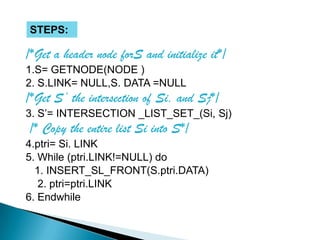
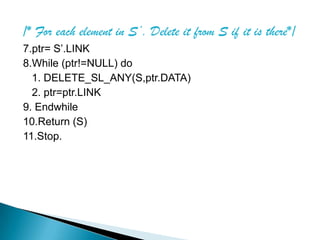

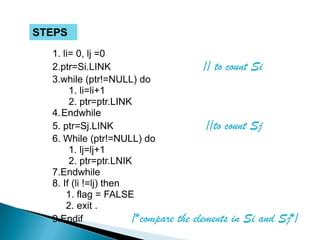
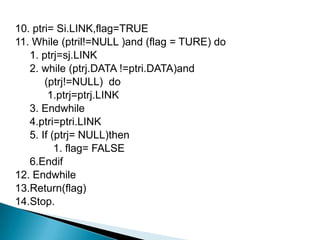



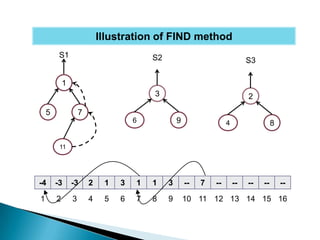
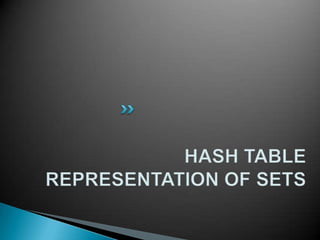


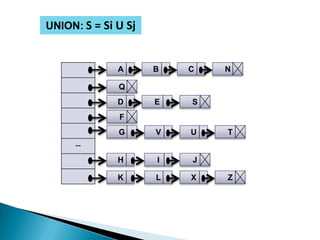




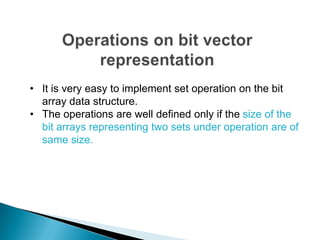


![1. li=LENGTH(Si) //Size of Si.
2. li=LENGTH(Sj) //Size of Sj.
3. If (li != lj) then
1.Print “Two sets are not compatible for union”
2.Exit
4. End if
/*Loop over the under lying bit arrays and bit-
wise OR on its constituents data.*/
5. For i=1 to li do
1.S[i] = Si[i] OR Sj[i]
6. EndFor
7. Return(S)
8. Stop](https://image.slidesharecdn.com/setdatastructure-2-120903115336-phpapp01/85/Set-data-structure-2-35-320.jpg)


![1. li=LENGTH(Si) //Size of Si.
2. li=LENGTH(Sj) //Size of Sj.
3. If (li != lj) then
1.Print “Two sets are not compatible for
intersection”
2.Exit
4. End if
/*Loop over the under lying bit arrays and
bit-wise AND on its constituents data.*/
5. For i=1 to li do
1.S[i] = Si[i] AND Sj[i]
6. EndFor
7. Return(S)
8. Stop](https://image.slidesharecdn.com/setdatastructure-2-120903115336-phpapp01/85/Set-data-structure-2-38-320.jpg)


![STEPS:
1. li=LENGTH(Si) //Size of Si.
2. lj=LENGTH(Sj) //Size of Sj.
3. If (li != lj) then
1.Print “Two sets are not compatible for difference”
2.Exit
4. End if /*To find the inverse (NOT) of Sj.*/
5. For i=1 to li do
1.Sj[i] = NOT Sj[i]
6. EndFor /*Loop over the under lying bit arrays and
bit-wise AND*/
7. For i=1 to li do
1.S[i] = Si[i] AND Sj[i]d
8. EndFor
9. Return(S)
10. Stop](https://image.slidesharecdn.com/setdatastructure-2-120903115336-phpapp01/85/Set-data-structure-2-41-320.jpg)
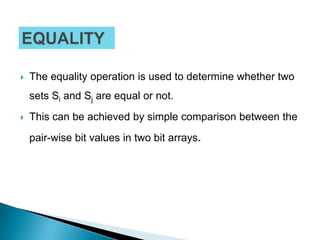

![1. li=LENGTH(Si) //Size of Si.
2. li=LENGTH(Sj) //Size of Sj.
3. If (li != lj) then
1.Return (FALSE) //return with failure
2.Exit
4. End if
/*Loop over the under lying bit arrays and compare*/
5. For i=1 to li do
1.SJ[i] != Sj[i] then
1.Return (FALSE) //return with failure
2.Exit
2.EndIf
6. EndFor
/*Otherwise two sets are equal */
7. Return(TRUE)
8. Stop](https://image.slidesharecdn.com/setdatastructure-2-120903115336-phpapp01/85/Set-data-structure-2-44-320.jpg)






![ How many students are there in engineering and
computer discipline?
To retrieve this information only bit arrays CS needs to
be searched for the number of 1‟s in it.
Who are the female students in CS discipline?
For this information do F CS or
[0 0 1 1 0 0 1 0 1 0] [1 0 0 0 0 0 0 0 1 0] =
[000000010]
Thus it gives the 9th record only.
How many students of General Category are there in
diploma or degree Module?
GN [P D]](https://image.slidesharecdn.com/setdatastructure-2-120903115336-phpapp01/85/Set-data-structure-2-51-320.jpg)


